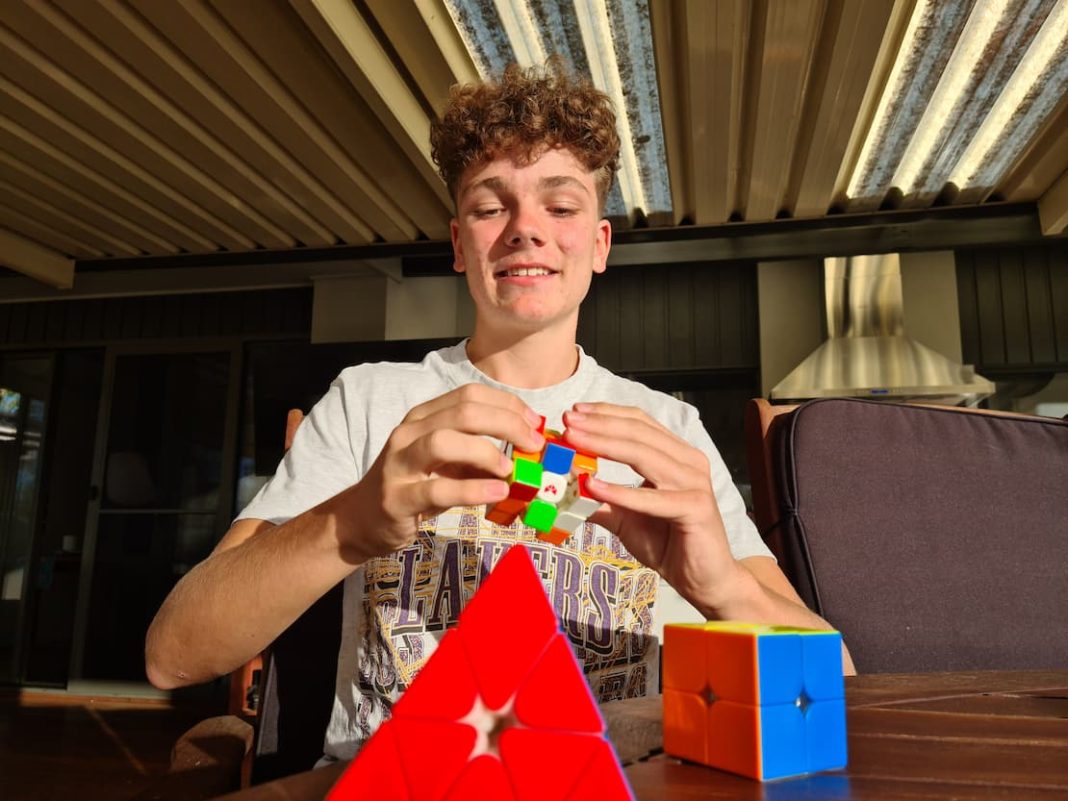I’m of the vintage when the Rubik’s Cube had stickers that could be peeled off to achieve success, but the ‘80s craze has become ultra competitive and Canberra student Liam Sawade – who averages 9.55 seconds at home – is contesting this weekend’s Speedcubing Australia competition.
The 15-year-old has Covid lockdowns to thank for his cubing expertise and is in the ACT’s top five speedcubers (no stickers, just a top-of-the-line $100 cube with a ball core and magnets for faster handling).
His cube of choice (apart from the common 3×3, there are 2×2’s, 4×4’s and so on) is the Pyraminx (pictured). Liam is ranked an incredible 18th in Australia.
“It was during the Covid period, I was bored, nothing to do at home so I picked up the cube, it was one of the stickers ones,” Liam said. “It had probably been sitting there for a few years now and one day I just really wanted to solve it. Then I did, and ever since then I just kept practicing over and over again.”
While we chat, Liam flicks a cube at lightning speed with one hand and solves it without looking at it. The key, says Liam, is to memorise algorithms. He then adds that there are 43 quintillion possible combinations for a 3×3 cube. Easy.
“You look at pieces and you memorise algorithms and put them into your muscle memory,” he said. “It doesn’t require a lot of math, but it does require faster action time and some really good memory. The most common method for training is to do solves over and over again. The best in the world, they can look at this entire [Pyraminx] cube and know the exact algorithms and moves you need to do. The fastest guys can do it in less algorithms, less moves. It’s half dexterity and speed, and half learning more algorithms.”
Don’t be disheartened readers, but the fastest person in the world is a nine-year-old boy from China, Yiheng Wang, who can solve a 3×3 in 4.48 seconds. He’s been cubing for less years than Australia’s national champ, 28-year-old Feliks Zemdegs from Victoria.
As a permed, legwarmer-wearing child of the ‘80s, I remember when the Rubik’s Cube reached its height in mainstream popularity. In what cubers call the “dry era” of the ‘90s and 2000s, the craze subsided. Then when an Aussie won the 2013 World Championships, it burst back on the local scene. Covid lockdowns helped too.
“I did have a point in 2021 where we were going back to school [after Covid lockdown] and I stopped doing it for about a year, but picked it up again in 2022. I thought it was just going to be one of those phases and that I’d drop it at some point but I just kept going with it.”
The good news is that you don’t have to be good at maths to excel at cubing, although it did help Liam when he was learning algorithms at St Francis Xavier College.
The year 10 student has only been cubing since 2022, travelling to Sydney for local comps, Queensland for the Australian National Championships and Melbourne for the Oceanic Championships. Liam hopes to go to Seattle next year for the World Championships.
“Now I’m a little bit faster, I made Australian National finals for the Pyraminx in 2023, I think the chance of me going to the World Championships is definitely higher,” Liam said. “This will be the first year during the Australian Nationals [In Adelaide in July] where we have a Canberra team in the state cup, where three people from every state compete. We’ve never had an ACT team.”
Next challenge for Liam is to cube blindfolded. He’s working on it. If he wants to go a step further, there’s a comp for cubing with your feet. This weekend, Liam’s aiming for a personal best in the Pyraminx.
The rules of the competition, in a regular 3×3 event, allows competitors 15 seconds to inspect the cube (scrambled by official “scramblers”) when the cover is lifted. Then the solve timer starts.
There could be a place for me as an official scrambler.
Capital Cubing in Canberra is on May 4-5, at Flynn Community Hub. First 3×3 comp starts 9.15am. Speedcubing Australia speedcubing.org.au is on Facebook and Instagram.



